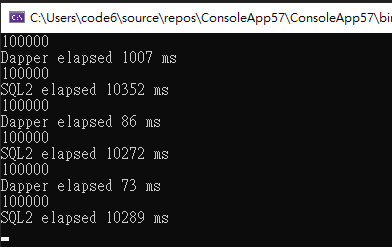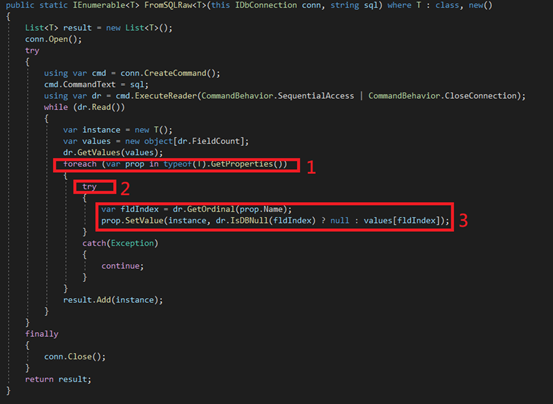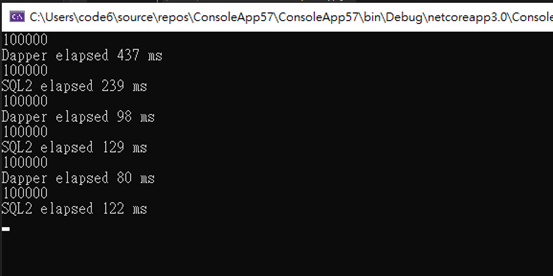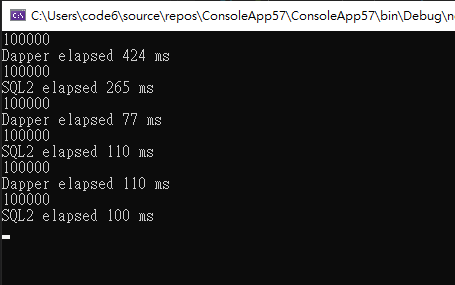在擔任技術顧問時最常遇到兩件事,一件是系統架構調整,另一件則是最大化產品價值,前者是用來維護、奠定日後的發展,後者則是在面對競爭者。一般來說,多數的產品在開發初期就會有假想敵,如果你遇到的是沒有假想敵的產品,那麼恭喜你,你拿到了商業模式中最有利的籌碼,就是稀缺性,但不幸的是,這樣的機率很低,在這個年代,多數的商業模式都已經被找出來,差別在於執行細節及價值的定義。本篇文章以 Dapper 做為假想敵,將追趕它的最有價值部分做一個紀錄,結果其實不是那麼重要,過程才是有趣的部分。
Dapper 的價值
Dapper 是 .NET/.NET Core 相當有歷史的套件,用於把 ADO.NET 取回的資料填充到物件裡,用一個專業術語來說,就是 Row Mapping,或是稍微放大成 Micro-ORM,Dapper 之所以可以長久不衰,在於其兩個價值,一是過人的效能,二是維持輕量,因此如果要以他為假想敵,那麼就要在這兩點上下手,例如擁有這兩個價值之外再加幾個附加價值來做出區隔,或是擷取其中一個最有價值的部分,把第二個換成另一種特色,另一種是把其中次要價值的部分再擴大,以完整性來取勝,不管哪種選擇,這兩個價值一定要有其一,而且不能做得比他差太多,否則就是找錯假想敵了。
先提一下,這種挑最強的硬碰硬,是很笨的行為,但有時沒得選擇,因為只要這點做的差太多,連擺上台的機會都沒有,合理的商業模式都是避開最強的部份,用別的來填充,但是重點是不能差太多,Dapper 是 Open Source,也就是白箱,但多數情況面對的是黑箱,因此這裡把 Dapper 當作黑箱,將整個追趕效能的部分記錄下來,如開頭所提,結果其實不是那麼重要,過程的思路是寫這篇文章最大的目的。
拉回主題,我認為 Dapper 最有價值的部分在於效能,這也是無法忽視的特質,Row Mapping 這種技術,說穿了就是利用 DataReader 把資料讀出來,然後塞到指定的物件裡,這裡的第一版選擇最快的解決方案,先做出雛形,再來調教。
public static IEnumerable<T> FromSQLRaw<T>(this IDbConnection conn, string sql) where T : class, new()
{
List<T> result = new List<T>();
conn.Open();
try
{
using var cmd = conn.CreateCommand();
cmd.CommandText = sql;
using var dr = cmd.ExecuteReader(CommandBehavior.SequentialAccess | CommandBehavior.CloseConnection);
while (dr.Read())
{
var instance = new T();
var values = new object[dr.FieldCount];
dr.GetValues(values);
foreach (var prop in typeof(T).GetProperties())
{
try
{
var fldIndex = dr.GetOrdinal(prop.Name);
prop.SetValue(instance, dr.IsDBNull(fldIndex) ? null : values[fldIndex]);
}
catch(Exception)
{
continue;
}
}
result.Add(instance);
}
}
finally
{
conn.Close();
}
return result;
}
這裡將處理函式設計為 Extension Method,這也是 Dapper 主要的處理方式,這不需要看到原始碼就可以猜出,不意外,效能真的是天差地遠。

不過雛型已經出來,我們可以標記可能的熱區,通常被執行最多次,或是迴圈中的東西都可以標記為熱區。

GetProperties()需要時間(1),而且是在迴圈裏面,所以這裡很明顯是可以最佳化的點之一,第二個是try….catch部分(2),由於處理 Exception 需要許多時間,尤其是真的有吐出來時,最佳化這部分其實花不了多少時間,所以放在優先處理區段,第三個可以想見是硬傷(3),因為反射的效能非常差,但是要處理這個需要花費許多時間,所以排在第二個,第二版鎖定處理 Exception及GetProperties部分。
private static int GetFieldIndex(string name, IDataReader reader)
{
try
{
return reader.GetOrdinal(name);
}
catch (Exception)
{
return -1;
}
}
public static IEnumerable<T> FromSQLRaw1<T>(this IDbConnection conn, string sql) where T : class, new()
{
List<T> result = new List<T>();
conn.Open();
try
{
using var cmd = conn.CreateCommand();
cmd.CommandText = sql;
using var dr = cmd.ExecuteReader(CommandBehavior.SequentialAccess | CommandBehavior.CloseConnection);
Dictionary<PropertyInfo, int> fieldMap = null;
while (dr.Read())
{
var instance = new T();
var values = new object[dr.FieldCount];
if (fieldMap == null)
fieldMap = typeof(T).GetProperties().Select(a => new
{ PropInfo = a, Index = GetFieldIndex(a.Name, dr) }).Where(a => a.Index != -1).OrderBy(a => a.Index).ToDictionary(a => a.PropInfo, v => v.Index);
dr.GetValues(values);
foreach (var prop in fieldMap)
{
prop.Key.SetValue(instance, values[prop.Value] == DBNull.Value ? null : values[prop.Value]);
}
result.Add(instance);
}
}
finally
{
conn.Close();
}
return result;
}
這裡我們用一個 fieldMap 搭配 GetFieldIndex 函式,將取得屬性、欄位的對應動作縮減至一次,也就是常見的快取手段,把可以快取的東西移入快取是效能最佳化的主要守則之一,但因為快取的出現,要特別小心過期或是額外付出的成本。

如圖,有很明顯的改進,但還是有近一倍的差距,看來不得不面對 PropertyInfo 的 SetValue 效能問題了,要處理這個,得退到 IL 層級,也就是不透過反射直接列舉 IL 來填充資料。
private static Action<TType, object> CreateTo<TType>(string property)
{
var type = typeof(TType);
var pi = type.GetProperty(property);
if (pi == null)
throw new ArgumentException($"property {property} not exists");
var method = new DynamicMethod($"{type.Name}_{property}_Setter", typeof(void), new[] { type, typeof(object) }, typeof(RowMappingHandler));
var ilgen = method.GetILGenerator();
ilgen.Emit(OpCodes.Ldarg_0);
ilgen.Emit(OpCodes.Ldarg_1);
if (pi.PropertyType.IsValueType)
{
ilgen.Emit(OpCodes.Unbox_Any, pi.PropertyType);
ilgen.Emit(OpCodes.Call, pi.GetSetMethod());
}
else
{
ilgen.Emit(OpCodes.Castclass, pi.PropertyType);
ilgen.Emit(OpCodes.Callvirt, pi.GetSetMethod());
}
ilgen.Emit(OpCodes.Ret);
return method.CreateDelegate(typeof(Action<TType, object>)) as Action<TType, object>;
}
public static IEnumerable<T> FromSQLRaw2<T>(this IDbConnection conn, string sql) where T : class, new()
{
List<T> result = new List<T>();
conn.Open();
try
{
using var cmd = conn.CreateCommand();
cmd.CommandText = sql;
using var dr = cmd.ExecuteReader(CommandBehavior.SequentialAccess | CommandBehavior.CloseConnection);
Dictionary<string, Delegate> mappedType = new Dictionary<string, Delegate>();
Dictionary<string, int> fieldMap = null;
while (dr.Read())
{
var instance = new T();
if (fieldMap == null)
fieldMap = typeof(T).GetProperties().Select(a => new
{ a.Name, Index = GetFieldIndex(a.Name, dr) }).Where(a => a.Index != -1).OrderBy(a => a.Index).ToDictionary(a => a.Name, v => v.Index);
var values = new object[dr.FieldCount];
dr.GetValues(values);
foreach (var pi in fieldMap)
{
if (!mappedType.ContainsKey(pi.Key))
mappedType[pi.Key] = CreateTo<T>(pi.Key);
((Action<T, object>)mappedType[pi.Key])(instance, values[fieldMap[pi.Key]] == DBNull.Value ? null : values[fieldMap[pi.Key]]);
}
result.Add(instance);
}
}
finally
{
conn.Close();
}
return result;
}
結果。

看來突破倍數的限界了,一般來說到這個階段已經可以打住了,因為再下去是Micro-Optimize,到達10位數以內的ms 世界,其實CP值已經沒那麼大了,而且還會增加維護的困難,不過這裡還是硬幹,以最後一個例子來說,Delegate部分其實可以進行快取,這可以加快第二次處理的效能。
private static Dictionary<Type, Dictionary<string, Delegate>> _mappingCache = new Dictionary<Type, Dictionary<string, Delegate>>();
public static IEnumerable<T> FromSQLRaw3<T>(this IDbConnection conn, string sql) where T : class, new()
{
List<T> result = new List<T>();
conn.Open();
try
{
using var cmd = conn.CreateCommand();
cmd.CommandText = sql;
using var dr = cmd.ExecuteReader(CommandBehavior.SequentialAccess | CommandBehavior.CloseConnection);
Dictionary<string, Delegate> mappedType;
if (!_mappingCache.TryGetValue(typeof(T), out mappedType))
{
_mappingCache.Add(typeof(T), new Dictionary<string, Delegate>());
mappedType = _mappingCache[typeof(T)];
}
Dictionary<string, int> fieldMap = null;
while (dr.Read())
{
var instance = new T();
if (fieldMap == null)
fieldMap = typeof(T).GetProperties().Select(a => new
{ a.Name, Index = GetFieldIndex(a.Name, dr) }).Where(a => a.Index != -1).OrderBy(a => a.Index).ToDictionary(a => a.Name, v => v.Index);
var values = new object[dr.FieldCount];
dr.GetValues(values);
foreach (var pi in fieldMap)
{
if (!mappedType.ContainsKey(pi.Key))
mappedType[pi.Key] = CreateTo<T>(pi.Key);
((Action<T, object>)mappedType[pi.Key])(instance, values[fieldMap[pi.Key]] == DBNull.Value ? null : values[fieldMap[pi.Key]]);
}
result.Add(instance);
}
}
finally
{
conn.Close();
}
return result;
}
結果。

恩,好一些了,但這只作用於第二次,重點在於要加快首次處理,我們知道,在使用 DataReader時,最快的方式是呼叫對應型別的取值函式,而不是使用 GetValues或是GetValue這種函式,這兩個函式會引發後續的box及unbox的效應,要做到這點,得為每個 Delegate 產生不同的形態,這大幅的增加列舉 IL 動作的難度。
private static Delegate CreateTo2<TType>(string property)
{
var type = typeof(TType);
var pi = type.GetProperty(property);
if (pi == null)
throw new ArgumentException($"property {property} not exists");
var method = new DynamicMethod($"{type.FullName}_{property}_Setter", typeof(void), new[] { type, pi.PropertyType }, typeof(RowMappingHandler));
var ilgen = method.GetILGenerator();
ilgen.Emit(OpCodes.Ldarg_0);
ilgen.Emit(OpCodes.Ldarg_1);
if (pi.PropertyType.IsValueType)
ilgen.Emit(OpCodes.Call, pi.GetSetMethod());
else
ilgen.Emit(OpCodes.Callvirt, pi.GetSetMethod());
ilgen.Emit(OpCodes.Ret);
return method.CreateDelegate(typeof(Action<,>).MakeGenericType(new[] { type, pi.PropertyType }));
}
public static IEnumerable<T> FromSQLRaw4<T>(this IDbConnection conn, string sql) where T : class, new()
{
List<T> result = new List<T>();
conn.Open();
try
{
using var cmd = conn.CreateCommand();
cmd.CommandText = sql;
using var dr = cmd.ExecuteReader(CommandBehavior.CloseConnection | CommandBehavior.SequentialAccess);
Dictionary<string, Delegate> mappedType;
if (!_mappingCache.TryGetValue(typeof(T), out mappedType))
{
_mappingCache.Add(typeof(T), new Dictionary<string, Delegate>());
mappedType = _mappingCache[typeof(T)];
}
Dictionary<PropertyInfo, int> fieldMap = null;
bool mapRoundDown = false;
while (dr.Read())
{
var instance = new T();
if (fieldMap == null)
fieldMap = typeof(T).GetProperties().Select(a => new
{ PropInfo = a, Index = GetFieldIndex(a.Name, dr) }).Where(a => a.Index != -1).OrderBy(a => a.Index).ToDictionary(a => a.PropInfo, v => v.Index) ;
foreach (var pi in fieldMap)
{
Delegate func;
if (!mapRoundDown && !mappedType.ContainsKey(pi.Key.Name))
{
func = CreateTo2<T>(pi.Key.Name);
mappedType[pi.Key.Name] = func;
}
else
func = mappedType[pi.Key.Name];
if (pi.Key.PropertyType == typeof(int))
((Action<T, int>)func)(instance, dr.IsDBNull(fieldMap[pi.Key]) ? -1 : dr.GetInt32(fieldMap[pi.Key]));
else if (pi.Key.PropertyType == typeof(string))
((Action<T, string>)func)(instance, dr.IsDBNull(fieldMap[pi.Key]) ? (string)null : dr.GetString(fieldMap[pi.Key]));
}
mapRoundDown = true;
result.Add(instance);
}
}
finally
{
conn.Close();
}
return result;
}
結果。

注意,這只是POC,我並未處理所有的型別,不過這已經足夠證明這個手法可行,但是代價是程式碼看起來越來越難維護了,一般來說到達這個階段就會暫時打住,移往另一個價值發展,畢竟在這硬碰硬太浪費時間了,以這個例子來說,LINQ 那個區段的結果可以快取,還有平展來取回一些效能,但代價是更難維護,所以先就此打住,事實上,Dapper 幾乎列舉了處理 DataReader 的整個函式的 IL,連Goto都用上了,再加上無所不在的快取。